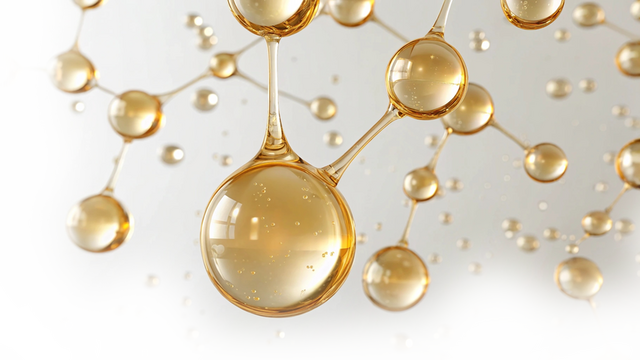
Panel discussion on...
Peptides
The evolving role of peptides in cosmetics: beyond anti-aging
In the tireless and ever-evolving world of beauty, few ingredients have captured as much attention as peptides. One of the earliest commercial advertisements dates back to 2006, when a beauty editor surprised audiences by declaring (1) “Right now, I think the hottest anti-ageing ingredients around are pentapeptides”.
However, the journey of peptides in cosmetics did not happen overnight. Their scientific exploration dates back over a century ago, with key discoveries like Fisher’s peptide synthesis in 1901 and the isolation of insulin in 1921. Their potential skin benefits gained attention in the 1980s and 1990s, and a breakthrough came in the early 2000s with the recognition of the anti-aging properties of palmitoyl pentapeptide-4 and palmitoyl dipeptide-7.
Since then, peptides have continued to charm formulators, marketers, and cosmetologists, always chasing their potential to improve skin elasticity or reduce the appearance of wrinkles. These small amino-acid chains have truly become a cornerstone of skin-rejuvenating formulations.
But while peptides have long been synonymous with anti-aging, could they offer more? Can they go beyond the oversaturated rejuvenation market? From this perspective, we try to explore some of the most exciting innovations in peptide technology, covering alternative applications and their impact on storytelling and claims within the industry.
Innovative peptide delivery systems
As peptide technology evolves, one source of innovation is the development of delivery systems to enhance their effectiveness. A key challenge in peptide formulations is their instability and limited absorption by the skin. To address this, researchers are exploring other encapsulation techniques.
For instance, a recent study by Hou et al. (2024) introduced “NanoGlow,” a technique that encapsulates peptide-based cosmetic ingredients into engineered nanosized plant-derived exosomes (pExo) (2). Exosomes are extracellular vesicles (30-150 nm) that naturally transport proteins, metabolites, and nucleic acids between cells. This technology aims to improve peptide stability and enhance skin penetration, making it a promising advancement for both cosmetic and medical applications.
Similarly, research by Chen et al. (2024) explores supramolecular collagen nanoparticles that combine lactoferrin, recombinant human collagen, and palmitoyl tripeptide-5 to enhance collagen penetration in skincare (3). A supramolecular assembly is a complex of two or more molecules held together by noncovalent interactions (4). In the study, these nanoparticles can improve skin hydration, elasticity, and brightness, positioning them as highly effective cosmetic ingredients.
Expanding peptide applications beyond anti-aging
Beyond slow aging, examining unconventional applications of peptides is also interesting. A notable example is palmitoyl dipeptide-18, which is listed in the Cosing database for its viscosity-controlling properties. This peptide was also registered in 2022 with China’s National Medical Product Administration (NMPA) for use as a thickener (5).
Another intriguing field is hair care. Molecules such as Copper Tripeptide-1 and Myristoyl Pentapeptide-17 are already used in mascara formulations, while keratin-derived peptides are commonly found in hair grooming products.
Recent research by Reihani et al. (2025) explores the combined effects of keratin peptides and natural oils encapsulated in nanostructured lipid carriers (NLCs) to enhance hair protection and restoration (6). These carriers improve the delivery of active ingredients, reducing hair damage and increasing moisture retention, paving the way for progress in hair care technology.
Multifunctional peptides: a new frontier
The next step in peptide creation involves moving from monofunctional to multifunctional peptides, with the capacity to address more targets at the same time (7).
The study from de Moraes et al, 2022 focuses on the rational design of synthetic peptides derived from the toxin latarcin-3a of the ant spider Lachesana tarabaevi (8). The peptides were assessed for their antibacterial and antitumor properties. While, of course, their primary application lies in medical research, these multifunctional ingredients could have cosmetic applications, such as enhancing product shelf-life by providing antimicrobial benefits.
One more striking example of multifunctionality that merges the anti-aging potential with the UV-protection, is presented by Li et al, 2024 (9). The research focuses on the development of peptide-melanin hybrid nanodots (PMHDs), which utilize melanin-like nanodots (MDs) to neutralize UV-induced oxidative stress, thus protecting skin cells. Enhanced with peptides, they help prevent the breakdown of collagen and elastin, preserving skin elasticity. In-vitro and in-vivo studies confirm their effectiveness, and this could open the doors to skincare formulations with broad uses.
Implications for marketing and communication
As we have seen through these few articles, while the peptide landscape continues to evolve, it is clear that their applications in cosmetics are far from limited to mature skin, wrinkles, and crow’s feet. What does this mean for marketing communication?
First, peptides could redefine the possibilities of beauty formulas, expanding beyond the market of anti-ageing products, moving into already known areas such as hair care and further expanding them, but also taking a look at uncommon functions like antibacterial applications or even hybrid and multifunctional cosmetic solutions.
This shift of perspective would allow brands to explore fresh storytelling approaches that are centered not merely on peptide functions but also on the technologies used to develop them. The benefit of highlighting the science behind peptide design - from encapsulation methods to hybrid nanostructures for example – would be reflected in adding depth to product narratives, possibly making them more compelling to consumers. It is worth discovering new spaces of dialogue with the consumers.
Secondly, while the safety profile of peptide must remain a priority, the efficacy shall also be considered a beacon (10). In this sense, the study of Ferreira et al, 2020 spots a major issue:
Furthermore, most peptides lack randomized clinical studies demonstrating their anti-aging efficacy in scientific literature, and there is an absence of systematic reviews summarizing the results from the existing studies. The scarcity of independent and peer-reviewed evidence regarding the efficacy of peptides in cosmetic products needs to be addressed by industry and the scientific community (11).
Thus, while in-vitro assays are the starting point, providing valuable insights into the biological efficacy of peptides, in-vivo studies involving human volunteers are essential for generating robust and regulatory-compliant data. This will ensure that the new stories shaped by marketing are backed by scientific rigor, reinforcing consumer trust, and aligning with advertising positions.
Conclusion
A few years after their first introduction, the leading role of peptides in the anti-aging market is established, and as science continues to evolve, applications and technologies are opening new viewpoints and landscapes. Ranging from advanced delivery systems to multifunctionality, peptides can potentially reshape the beauty industry. Future narratives should boldly integrate scientific innovations with effective communication and solid data, to bring us far beyond the shared aspiration of “looking younger.” There is much more to dream about.
Panelists
References and notes
- The history of peptides (no date) Skin Rocks. Available at: https://skinrocks.com/blogs/caroline-hirons/the-history-of-peptides#:~:text=Basically%2C%20when%20skin%20is%20injured,of%20the%20proteins%20that%20is (Accessed: 17 February 2025).
- Hou, J. et al. (2024) ‘Developing plant exosomes as an advanced delivery system for cosmetic peptide’, ACS Applied Bio Materials, 7(5), pp. 3050–3060. doi:10.1021/acsabm.4c00096.
- Chen, W. et al. (2025) ‘Supramolecular collagen nanoparticles for anti-wrinkle, skin whitening, and moisturizing effects’, Colloids and Surfaces B: Biointerfaces, 245, p. 114275. doi:10.1016/j.colsurfb.2024.114275.
- Supramolecular assembly (no date) Supramolecular Assembly - an overview | ScienceDirect Topics. Available at: https://www.sciencedirect.com/topics/pharmacology-toxicology-and-pharmaceutical-science/supramolecular-assembly (Accessed: 17 February 2025).
- Wang, L. et al. (2025) ‘Overview of peptides and their potential roles in skin health and beauty’, Journal of Peptide Science, 31(2). doi:10.1002/psc.3668.
- Reihani, N. and Ghourchian, H. (2025) ‘Synergy of keratin peptides and natural oils embedded in nanostructured lipid carriers to protect and restore human hair structure’, Journal of Molecular Liquids, 422, p. 126957. doi:10.1016/j.molliq.2025.126957.
- Multifunctional peptides (no date) Multifunctional Peptides - an overview | ScienceDirect Topics. Available at: https://www.sciencedirect.com/topics/biochemistry-genetics-and-molecular-biology/multifunctional-peptides#:~:text=As%20described%20by%20Lammi%20et,monofunctional%20peptides%E2%80%9D%20%5B163%5D (Accessed: 17 February 2025).
- de Moraes, L.F. et al. (2022) ‘First generation of multifunctional peptides derived from LATARCIN-3A from Lachesana Tarabaevi spider toxin’, Frontiers in Microbiology, 13. doi:10.3389/fmicb.2022.965621.
- Li, P. et al. (2024) ‘Multifunctional peptide-melanin hybrid Nanodots with robust anti-cutaneous photoaging activity’, Journal of Analysis and Testing, 8(3), pp. 395–401. doi:10.1007/s41664-024-00311-4.
- Peptides and proteins in cosmetics – part 2 (safety aspects) (2024) Biorius. Available at: https://biorius.com/cosmetic-news/peptides-and-proteins-in-cosmetics-part-2-safety-aspects/ (Accessed: 17 February 2025).
- Ferreira, M.S. et al. (2020) ‘Trending anti-aging peptides’, Cosmetics, 7(4), p. 91. doi:10.3390/cosmetics7040091.




































